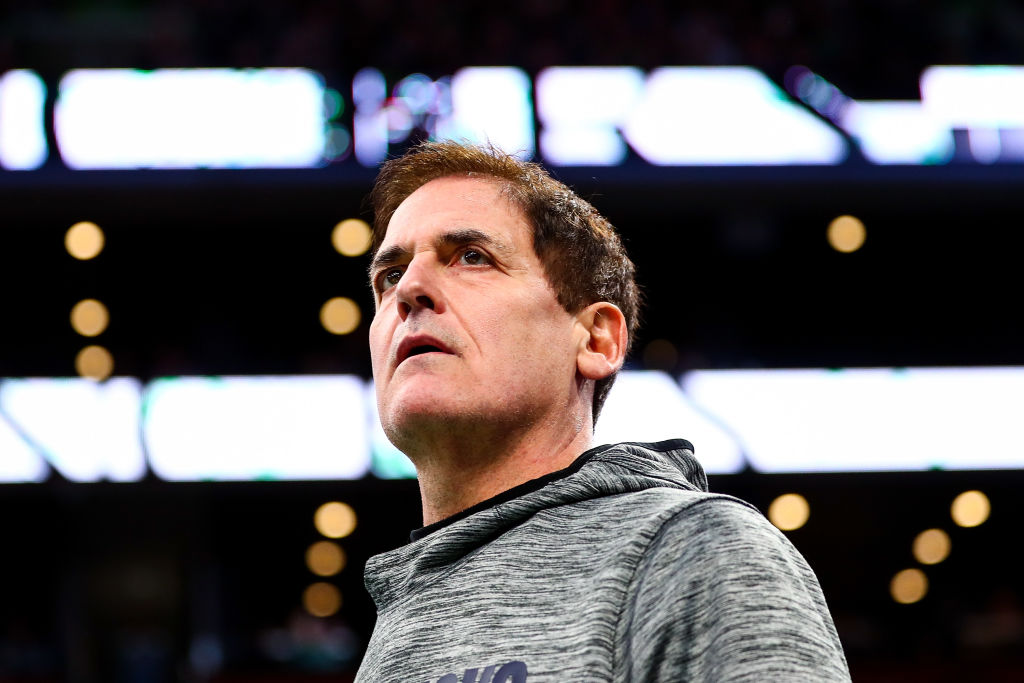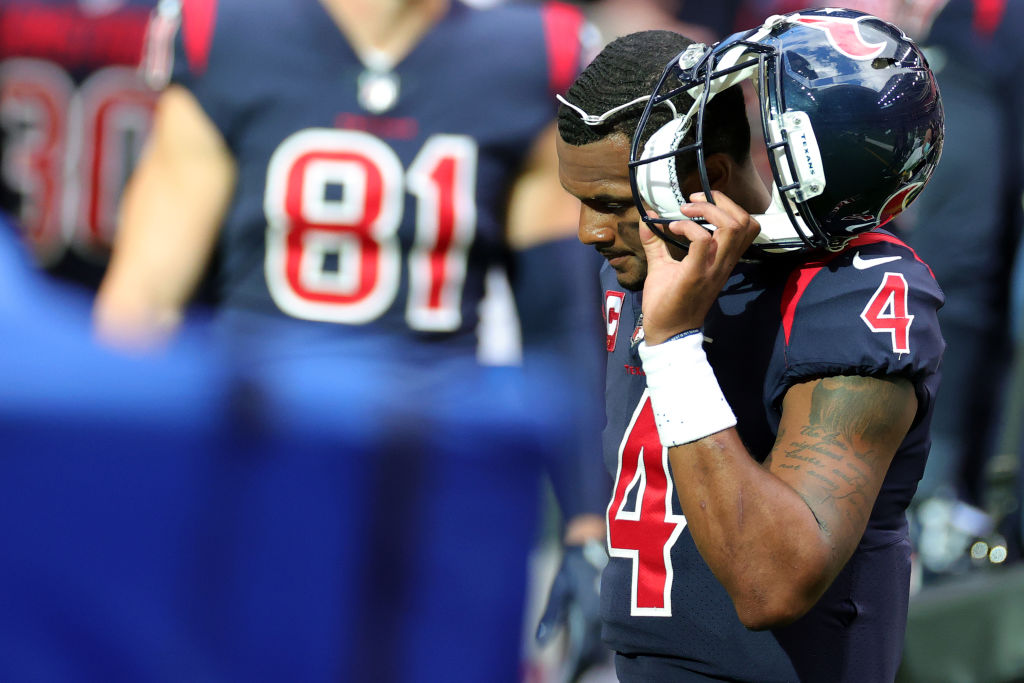Gendered Violence Cases Challenge Sports Journalists To Consider And Reconsider Each Word They Write
Why this matters
When a news story breaks about a sports figure such as NFL quarterback Deshaun Watson, the media snaps to attention. As stories develop, every journalist must evaluate the potential effect of each word and phrase as they report on both sides of an issue. Investigative journalist Jessica Luther shares wisdom gained from covering high-profile gender violence cases in college and professional sports.
In March, the conversation around Houston Texans quarterback Deshaun Watson dramatically shifted. For the first three months of the year, sports media focused on Watson’s general unhappiness with the team, whether he would be traded, where he might possibly go, and how things had gotten to this point.
Then, beginning on March 16 and continuing over the next few weeks, 22 women filed lawsuits against Watson, all of them saying that during massage therapy sessions with him, Watson committed sexual misconduct ranging from exposing himself to forcing oral sex.
Discussion of Watson’s possible trade to another National Football League team did not disappear. But almost overnight, the same journalists who cover Watson’s on-field athletic feats and the Texans’ business decisions were tasked with reporting on the complicated and layered topic of gendered harassment and violence off the field. This can be a difficult transition. A Texans beat reporter at the Houston Chronicle found himself out of a job after appearing on a sports radio show and calling the lawsuits “a money grab” and “ambulance chasing.”
In between that appearance and his quiet dismissal from the Chronicle, that same reporter published a front-page cover story for the newspaper that looked at the lawsuits from the point of view of Watson’s friends and family. I emailed with the Chronicle’s editor and spoke to the reporter by phone to relay my concerns about the framing of the piece, which I found to be one-sided, reductive, and facile.
I didn’t come to those conclusions lightly. Over the past eight years, I have reported on a number of different stories involving sports and gendered violence – including Baylor University’s silence and the fallout from it, the culture of the Dallas Mavericks, and how Louisiana State University responded to reports of sexual assault – and have written a book on the same topic. It seems like every few years I pen a piece after someone in the sports media fails to cover gendered violence as carefully or thoughtfully as they should. I could do that again regarding Watson, but since journalists Diana Moskovitz and Dan Solomon already have covered that ground, I don’t think that would be helpful.
Instead, I want to share some of what I have learned – and what I think about when reporting and writing in this area – in the hope that the next time members of the sports media are asked to pivot quickly to covering gendered violence, they’ll have a road map to guide them.
What (and How) We Write Matters
Covering gendered violence is difficult work. By every measure, the numbers show it is greatly underreported, and our societal-wide ideas about it are often incorrect and/or tinged with misogyny and victim-blaming. Most of these cases are not resolved within the legal system; if they are, it often happens in civil court, and we learn very little about their outcomes.
How the media reports on these cases can have a real impact on whether other victims or future victims are willing to come forward to their friends and family, the media or the public, a university, and/or the police. Headlines alone can help shape our cultural ideas about sexual violence. How reporters, writers, and editors approach the subject and do their jobs can have serious and lasting consequences.
Related: Belonging in Sport: Share Your Story
This is particularly true when gendered violence intersects with sports. The big-money nature of the industry, the special attention we shower upon it – there’s an entire sports media infrastructure – and fans’ personal investments in their teams means that these cases can be very high-profile. Their outcomes can have an impact on which players or coaches are able to take the field, court, or pitch. People can find themselves with a chance to literally cheer for those accused of harming someone – and, chillingly, some fans take that opportunity when presented to them.
A 2013 study found that this phenomenon can have real-world consequences. A group of researchers interviewed a few hundred college students and found “that individuals who consume more sports media may be more likely to tolerate sexual assault” and would be less likely “to intervene when they witness a situation they perceive could lead to a sexual assault.” Bystander intervention can range from telling someone their rape joke is not OK to physically stopping an instance of sexual assault – and, as the study notes, “a willingness to intervene among members of the community establishes an environment in which sexual assault is not accepted.”
The researchers found that, in particular, men’s “exposure to sports media was negatively associated with intentions to intervene.” Ultimately, the researchers warn not to extrapolate too much from their study, in part because they could not determine if sports media actually affects people’s actions or if it’s that people who consume sports media tend to be people who would not intervene in the first place. Either way, there is a connection between people who watch sports, the media’s coverage of gendered violence, and the ways people respond to that violence in real life. It’s important that journalists get this type of reporting right from the jump.
Framing and Word Choice
Most sports coverage is about individual players, their teams, the university or organization for which they play, the coaches who lead them, and the owners of teams. There are in-depth articles about the lives of players off the field, their relationships with their teammates and family members, and the things that make them tick on the field. There is also, of course, game analysis, predictions, and endless discussion of it all on TV and radio. So it makes sense, on some level, that when sports reporters have to report on gendered violence, they tend to center the athlete or coach who is accused or to only consider the impact of the allegations on the player or the team.
Unfortunately, this creates one-sided accounts that sometimes erase victims completely.

The simplest way to work against this tendency in a story is to reimagine its audience. It is not only sports fans, the player, the coach, and people associated with the team who will read your article. It’s also survivors of gendered violence and perhaps even the victim in the case being covered. Often, especially in college athletics, the person harmed is an athlete, too. A bigger imagined audience forces you to be more careful with your words on both sides of the story and to constantly consider who will be affected by what you write.
As for balancing the reporting itself, this can be difficult given that we don’t always know the identity of the person who has reported the harm. Their identity is often protected by the courts – and even if the media does know, there is only so much a reporter can say about a victim so as not to reveal information that can potentially put the victim at risk. To get some understanding and context for what it means to report this kind of harm, turn to the local domestic violence organizations or sexual assault/rape crisis centers in the community. Most have someone who can talk to the media about how these cases work and about the consequences for people who report violence. These conversations can greatly help a reporter think through the particular case at hand.
Other things to consider:
- Do not use the passive voice. The use of the passive voice is so pervasive in reporting on sexual assault and domestic violence that it has been studied extensively by academics. One study found that news stories with active verbs led readers to attribute agency and responsibility to people in the piece, compared with the same story rewritten with passive verbs.
- Be clear about what someone has reported. Do not shy away from recounting the violence, though avoid sensationalizing it. It is a fact in the piece alongside all the others. To that end, try to quote what the victim or witnesses say happened rather than paraphrasing. Pay particular attention to the language a source or a victim uses when describing themselves and their experiences, and let that guide your word choice.
- Try to avoid words like “alleged” and “allegedly.” They have their place, sure, but they also now have a negative connotation, functioning as placeholders to constantly remind readers to cast doubt. “Allegedly” is so commonly used in this reporting that I will often open an article and immediately search to see how many times the word appears. In many cases, using “says” will do. I will search my drafts for the word and then rewrite the sentence to tell the reader as straightforwardly as possible who said what to whom. This often results in stronger pieces that don’t tell the reader what to believe or disbelieve.
Talking to Victims
One of the trickiest and most important parts of this work is reaching out to and interviewing people who say they’ve been harassed or harmed. It takes time and care.
If you are cold-contacting someone – as opposed to them reaching out to you first – be aware that receiving your call, email, or Instagram DM will probably be a jarring, if not downright scary, experience for them. I suggest using language like “I am working on a story about X, and I heard you might have a story to tell.” I also try to assess if there is any potential risk to their safety if I reach out. Are they still with the person whom they reported? If I leave a message at this phone number, could their parents or guardians learn about something the person has yet to disclose to them? If I reach them at work, could being contacted by a journalist jeopardize their job?
If they agree to talk to you, set the ground rules immediately. Discuss with them if the interview is off record, on background, or on the record, and if they want or need to be anonymous or pseudonymous. Make sure there is a mutual understanding of what those terms mean.

The first time someone tells me their story, I let them lead. I try to interrupt as little as possible – only when I am genuinely confused about something. It’s hard for anyone to tell a story straight from beginning to end, and even more so when someone recounts a story involving trauma. Expect their chronology to wander, so make notes as they talk so you can go back and ask questions once they finish. Perhaps most importantly, do not judge their choices and actions. My experience has taught me that there will come a time during the interview when your source will tell you something and expect you to judge them—they had sex with the person after they were assaulted; they did not report to the police; they texted politely with the person three days later; whatever – and by remaining silent or simply saying “OK,” you can put them at ease. Disclosing a story like this to a stranger can be intimidating, so I always thank them for trusting me.
Sometimes people who have been harmed will say “no” to your interview request. You have to be OK with that.
Fair journalistic practice also means that you have to give the person whom they reported a chance to respond to whatever you are planning to publish. In my experience, it’s uncommon to get an interview with the accused – but you have to put in a good faith effort to do so. Even if a one-on-one interview is not possible, there is often something with which to work, especially if you are dealing with a high-profile athlete. They may have released statements, conducted a news conference or answered another reporter’s questions, or posted something on social media. Rounding out coverage from both ends of the story is crucial.
Documents
It’s important to collect as much documentation as possible. Despite the fact that we are often told that these are “he said/she said” cases – which implies that the only evidence is each person’s story – there can be a fair amount of documentation to back up a person’s account. Consider requesting reports from not only the local police but also the sheriff or campus police who might have jurisdiction over that area. (Note: It’s important to be as skeptical of these documents as you would be of any other.) Check with the clerks of the district and federal courts to see if there are documents on any individuals involved in the case. Make sure to check PACER for lawsuits.
Ask your sources if they have hospital or clinical records that could corroborate dates, times, or even the physical effects of the violence. Do they have any notes they wrote down? Can they pass along emails with the person they say harmed them, or with any university officials, or people who work for the team? What about text messages or direct messages from social media such as Facebook Messenger? Do their parents or partners have anything like this?
If you are working with someone who was harmed in college, ask them for any paperwork generated from reporting to the school, especially any records from Title IX or Office of Inclusion and Equity. Requesting that kind of documentation from a school most likely will be frustrating for a whole host of reasons, most notably the Family Educational Rights and Privacy Act (FERPA). Still, you can and should request documents from the school – even if you expect pushback.
Pitfalls to Avoid
There are many pitfalls to consider when reporting on the intersection of gendered violence and sports. Given that many high-profile football and basketball players are Black men, it is important to take into account the history of race and sexual assault in the United States. Black men have been hurt and killed over accusations of sexual violence, especially against White women. They are deemed “dangerous” or “criminal” by simply existing in Black skin. Meanwhile, Black women and other women of color are rarely imagined, much less reported on, as victims of gendered violence despite the fact they are more likely to be harmed than White women.
These realities do not need to show up on the page every time you write about this topic – but they should always be at the front of your mind as you decide how to frame your story and choose your words.

Second, understand that false reports of sexual assault are rare. Though it’s hard to pin down exact numbers, the odds that a report is false are very low, somewhere in the single digits. Domestic abuse victims will sometimes recant – but there are good reasons for this that have nothing to do with the veracity of their reports. As such, it’s wrong to write as if false allegations are as likely as true ones. There are other statistics to consider, too. Men are more likely to be victims of sexual assault than falsely accused of it. As research and program associate Cameron Kimble wrote for the Brennan Center law and policy institute, “statistically speaking, it is far more common for a survivor of sexual assault to decline to report it than for someone to make false accusations of assault.” All of this should play a role in how a journalist approaches reporting on this topic.
It’s also very easy in this work to lose the forest for the tree if you are not clear about what you want to accomplish by doing this reporting. Is the point to focus on a single individual or one story? Or is it to more broadly question how a team, a university, a league, fans, owners, and others respond to these reports? Sometimes, your mission is to zero in on a single case. Even so, it’s important to remember that these stories are never divorced from larger society and can serve to shine a light on how powerful sporting institutions work, whom they protect, and why.
Finally, do not assume that any story is finished. Title IX investigations can stretch on for months and years. Criminal cases and civil lawsuits often unfold slowly and can work their way through the courts for many years. Deshaun Watson is currently facing 22 lawsuits – so it could take another four or five years, if not longer, for all of them to be resolved. While investigations and legal processes play out, the people who harm – or those who enable them or ignore the harm – can go on to repeat harmful behaviors. In the longer term, universities or leagues that say they are going to change their processes or policies do not necessarily follow through, or they do so only partially.
And, of course, the effects on those harmed can last a lifetime. Given all of this, the least we can do as journalists is maintain our sustained attention and keep our eyes on the ball.
Other Resources
When it comes to the intricacies of reporting on gender violence, all of the above is just a starting point. There are many great resources for reporters – resources I often return to when I’m working on these stories. Here are some of the best:
- “Reporting on Rape and Sexual Violence,” a media toolkit from the Chicago Taskforce on Violence Against Girls & Young Women
- Rhode Island Coalition Against Domestic Violence’s guide for journalists covering domestic violence
- “A Guide for Journalists” from Know Your IX
- “Resources for Reporters, Editors, and Media Professionals” from The National Network to End Domestic Violence
- A list of resources from the National Sexual Violence Resource Center for “Reporting on Sexual Violence”
- Ethical Journalism Network’s 6-point guide to ethical reporting on domestic violence
- “Reporting Sexual Assault: A Guide for Journalists” from the Michigan Coalition Against Domestic and Sexual Violence
- The CDC's guide to “Reporting on Sexual Violence”
- Nevada Network Against Domestic Violence’s “Covering Domestic Violence: A Guide for Media Professionals”
- The DART Center for Journalism and Trauma’s pages on “Sexual Violence” and “Intimate Partner Violence”
Monthly Issue
Beyond the Binary in Sport
The spectra of sex, gender, and sexuality challenge our traditional understanding of sport and competition, but are increasingly central to the conversation around athlete and fan experience.
With legislation and organizing increasing around how these various identities intersect, sport makes a natural landscape for discourse and broadening our knowledge of these conversations. How are perspectives changing, and what can we discover by diving into the multitudes underneath these nuanced topics?






